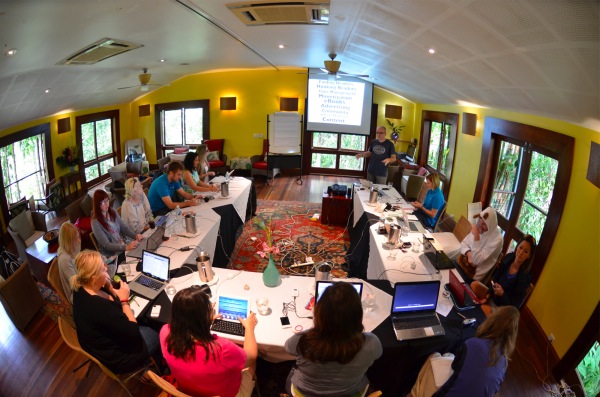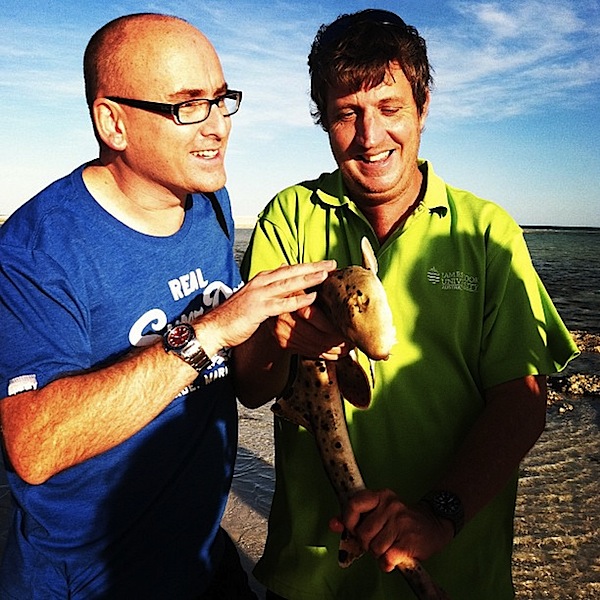 | Blog Tips to Help You Make Money Blogging - ProBlogger http://www.problogger.net рекомендовать друзьям >> |
- Experience The Great Barrier Reef Queensland with 10 Bloggers from Around the World #QldBlog
Greetings from Far North Tropical Queensland where I’m writing this post from as part of the ProBlogger Queensland Blogger Trip.
You may remember a couple of months back we ran a competition here on ProBlogger to identify 10 bloggers from around the world to win an all expenses trip to the Great Barrier Reef in Queensland to experience all that the region has to offer and then to blog about it. The winners were previously announced here and the trip began earlier this week.
FOLLOW ALONG: You can follow along on Twitter and Instagram of those on the trip by following the hashtag #QldBlog where there are loads of photos and updates happening (and a few blog posts already going up).

We all arrived over a 24 hour earlier in the week before all meeting in the lobby of our Cairns hotel on Tuesday evening. Our first experience was to travel to a local Indigenous Art Gallery (Canopy Artspace) where we had a ‘welcome to country’ by one of the local indigenous leaders and had opportunity to meet some of the local indigenous artists.

Their work was fascinating and I found myself particularly moved by some of the pieces.
We then had a great dinner together where we got to know each other as a group and began to hear about the days ahead.
Yesterday was our first full day and it was a very very full one. Most of the day was spent out in the Coral Sea off the coast of Cairns at a little resort Island by the name of Green Island.
There we had opportunity to sit with each other for 3 hours for our first blogger training session. We spent the doing a ‘hot seat’ exercise where each blogger introduced their blog and then the rest of the group brainstormed/critiqued/workshopped that blog.

The conversation was great – we had a range of levels of bloggers in the room – from those who were doing blogging as a serious hobby through to those who were full time bloggers employing staff to run their blogs (and everyone in between).
The rest of the day was spent taking in the sights of the area.
Most of the bloggers had opportunity to go ‘Sea Walking’ (walking underwater with a pressurised helmet on their head).

Rebecca Cooper from Simple As That

We were then put on 3 helicopters and taken out to Vasslof Cay – a little coral sand island in the middle of the reef where we spent time with Marine Biologist – Richard Fitzpatrick, one of the guys that recently shot the amazing ‘Great Barrier Reef’ documentary.
The flight to the Cay and time with Richard was surreal. For many of our bloggers it was their first helicopter flight. The views were stunning. The Cay itself was beautiful. Richard was fascinating.

As we spoke with Richard one of the team noticed some splashing in the shallows just off the Cay. At first they thought it was a Turtle but Richard quickly realised it was a small shark… two in fact… mating.
Richard was off like a shot running into the water and shouting that this was one of the rarest things you’ll ever see. He scooped into the water and picked up the male shark and for the next 10 minutes we had a lesson that we’ll never forget about the lives of sharks.

I even got to pet it (photo: of myself and Richard – taken by Tsh from SimpleMom)!
We were then shuttled back to Cairns where we had 45 minutes to freshen up before being taken to one of the most beautiful restaurants in the region – NuNu in Palm Cove where we were serenaded by a ukulele band and watch a big golden moon rise above the water of the beach before us.
It was like nature and the team at Tourism Queensland had conspired to give us the ultimate night out.
Today we switch gears a little and are heading away from the reef into the Daintree rain forest. This is a unique region in that it has two world heritage listed areas (the reef and rainforest) so close.
We’ll spend another 3 hours this morning doing some more blogger training at Silky Oaks Lodge next to the Mossman River and then in the afternoon have opportunity to do a rainforest walk and get a Spa Treatment – pedicure or massage anyone?
We’re also checking in tonight to an amazing resort Thala Beach Lodge which I am told is a unique and amazing place to stay.
Please check out the #QldBlog for more regular updates of what our bloggers are doing!
Also check out the bloggers on the trip’s blogs where posts will start to go up in the coming days:
- Rebecca Cooper (Canada) of Simple as That (see her announcement post)
- Tsh Oxenreider (USA) of Simple Mom
- Chantelle Ellem (Australia) of Fat Mum Slim (read her announcement post)
- U Mei Teh (Malaysia) of CC Food Travel (read her announcement post here)
- Katja Hentschel (Germany) of Travelettes
- Stuart Flatt (UK) of Average Joes Blog
- Kara Williams (USA) of The Vacation Gals (see her announcement post here)
- Jodi Friedman (USA) of MCP Actions (see here announcement post here)
- Jackie Hutchings (UK) of Scubadviser (read her announcement post here)
- Jess Van Den (AUS) of Epheriell Designs
Originally at: Blog Tips at ProBlogger

Experience The Great Barrier Reef Queensland with 10 Bloggers from Around the World #QldBlog

Переслать - 5 Ways Blogging Supports a Multichannel Marketing Strategy
This guest post is by Geoff Livingston of Marketing in the Round.
With so many marketing tactics to choose from, it seems off that more and more businesses elect to forgo blogging.
No, blogging is not easy. Blogging takes writing skills, creativity, and other centric behavior. It requires constant thought and value creation for readers.
However, given the world’s growing adoption direction of digital and increasingly mobile media, it’s hard to see how any business can avoid content creation. The easiest way to create content in a searchable manner remains blogging.
Blogging fits into a multichannel marketing strategy in four key ways.
1. Lead with blogs
If your business is truly a small online endeavor, your blog may simply be the leading driver of inbound marketing leads. In this case, you already understand the importance of blogging well and regularly.
For larger entities, some initiatives like new products and offerings require seeding. Interacting with community members via blogs and associated social networks offers the best way to begin a marketing initiative.
Blogging new ideas engages die-hard customers and loyalists in the conversation first. They are your word-of-mouth army. If the concept holds water, customers will engage, and perhaps even sharpen your offering with feedback and opportunities.
Then, as you deploy other marketing initiatives, you have already made your concept searchable, adding a foundation for long-term marketing initiatives.
2. Use blogging to support larger initiatives
I recently published a new book with Gini Dietrich on integrated communications, called Marketing in the Round. We discuss the many approaches a small business or entrepreneur can choose to lead, including blogging. Comparatively, advertising, media relations, social network-based activity, and direct marketing can all take precedence.
We recommend using tactics like blogging to support the four approaches to marketing.
Content—and specifically blogging—fulfills a valuable role in the marketing lifecycle. It helps you become searchable, it gives people something to talk about online that’s related to your business, and finally, it allows people to qualify you or your business.
Publishing content on a blog provides the honey that attracts the bees. With other initiatives driving interest, inevitably potential customers will search for information about you, either on Google, Bing, or Yahoo!, or through their social networks.
Use blogs to publish value-added content that continues the experience you’ve started with other marketing tactics.
3. Undercut the competition
Competitors. Can’t we live without them?
If your product or service has value, it’s inevitable that that competitors will arise or react to your offering. Fortunately, there are a few ways you can deploy blogging to counter competitive offerings online.
First, take a karmic marketing approach, and blog about larger industry trends, including what your competitors are doing right. Make sure you link to them with critical keywords.
Guess what? When they get searched, your blog should get sourced in the results. Hopefully, potential customers will click through.
Say your competition undercuts you by positioning you inaccurately. It’s certainly happened to me. Respond, perhaps not directly, but address the concerns and misrepresentations clearly. It’s important to state the facts here. Whenever the issue comes up, show people the blog post that offers a clear picture of your offering.
Perhaps you want to respond to a new competitive offering through innovation. Blog about potential weaknesses in the competing product and see what your stakeholders have to say. Perhaps they will give you insights you’d never have gained otherwise.
Again, take a karmic approach here, and don’t attack them publicly. Rather, speak to the issues their product presents.
4. Inspire word of mouth
So much of today’s conversation revolves around content marketing. Even this blog post discusses it at great length.
Content marketing represents a push to the marketplace. That’s not necessarily a good thing, as many people want to have a conversation with brands (even small ones), not receive messages.
Conversations provide word-of-mouth discussion of your brand. Peer discussion remains one of the most trustworthy forms of dialog a brand can produce.
If we step away from the blog itself, a business exists to solve problems, often with an idea that manifests itself as a product or service. Ideas provide a primary conversation topic online.
Use your blog as an idea virus generator. Literally use it to inject new ideas, concepts, and thoughts into the marketplace for larger conversation. Give people something to talk about, starting with your idea.
Let their conversation create the need and the justification for your product and services. In turn, you receive the benefits of a strong word-of-mouth conversation.
5. Content market with visual assets
Sometimes we’re get caught up in the blogger’s journey. As a blogger of seven years and a writer of 20+ years, I can identify.
But blogs are online publishing platforms, nothing more. You can publish just about any kind of content on a blog.
This matters in today’s online world. More and more people access the internet through smartphones and tablets. In turn, because touch interfaces hamper textual input, we’re seeing commenting levels drop. Smaller screens make reading harder, which increases the importance of publishing visual assets.
Your optimized blog already drives content into search. It should also serve new portable media users with visual content that gives them the information they need.
Integrate visual assets into your blog. Publish photos, infographics, charts, graphic design, and more. Make your blog a visual garden, and allow people to share and use these visual assets. In turn, word of mouth and search strength for your visual content increases.
Heck, you can even feature ads so long as you discuss them in a conversational, interactive way. For example, ask “What do you think of this creative?” Even let your customers choose the final design. Above all, make visual content engaging.
Conclusion
Because blogging offers so much strategic versatility, it has many uses in a multichannel campaign. However you choose to proceed with your blog, consider it a powerful tool within the larger context. Remember: blogs are not islands.
Geoff Livingston is an author and marketing strategist, and serves as VP, Strategic Partnerships for Razoo. A former journalist, Livingston continues to write, and most recently he co-authored Marketing in the Round, a book that shows you how to get more value from all your marketing and communications channels integrated together!
Originally at: Blog Tips at ProBlogger

5 Ways Blogging Supports a Multichannel Marketing Strategy

Переслать - 10 No-Nonsense Ways to Build Backlinks
This is a guest post by Gregory Ciotti of Sparring Mind.
Many bloggers are very much averse to participating or learning anything about SEO, and truth be told, I think that’s a real shame.
Maybe my time with my SEO agency has made me biased, but I personally think most bloggers are missing out on a huge potential source of traffic by just plain ignoring how search engines work and what practices are most effective.
The truth is, SEO for blogs doesn’t have to be overly complicated or require “black magic” in order to work.
My “World’s Simplest SEO Formula for Great Rankings” is:
- Craft amazing content that’s built for readers, not search engines.
- Get great links to that content.
Okay, so SEO can obviously be a lot more complex than that, but if you’re a blogger just looking for the essentials, that two-step process is actually relevant.
The problem most bloggers run into is this: how do we actually get those “great links” to our content?
Today I’d like to break down a “no-nonsense” guide to attracting (and outright earning) some powerful links. We’ll skip stuff like forum profiles and social media bookmarking. The links we’re going after are going to be powerful and actually send us traffic. Let’s get started.
1. Check your competitors’ backlinks
If there is one great way to find good backlink ideas, it’s to check out what your competition is doing.
While “old faithful” (Yahoo! site explorer) is now a part of Bing’s webmaster tools, there are still a few great options around.
My current favorite is the Open Site Explorer, an excellent backlink tool created by the knowledgable folks over at SEOmoz.
With the free version, you can check where links are coming from (that is, domains and pages). While the premium offering gives you far more insight, you can generally get a good idea with just the free version.
Did your competitor get linked to from a publication/blog that covers your niche? Email the author personally and let them know about a piece of content that you created (or about your site in general) and offer to give them a story to help them out.
That part is essential. Emailing people with direct requests or not-so-subtle begging to “please link to me!” is not going to work.
Fixing a problem that they have (for journalists, this is generating new stories, for bloggers, new guest posts could fit the bill) is the key to getting a link.
You may also find other communities that have linked to your competitors: relevant sites, resource pages, etc. If your competitor can get a link there, so can you.
2. Create a site for readers, not Google
This may seem counter-productive, but hear me out.
As time goes on, search engines (notably Google) are beginning to become more and more in tune with following people, rather than with following links.
I’m not going to sit here and tell you that links won’t matter in a few years (they will, for a long time), but I am telling you that the more you focus on creating a site filled with content that’s meant to be enjoyed by real people, the better your site will do in search results.
With Google recently making moves to punish “over-optimized” sites, you have to recognize that fact that a site built just to rank runs the risk of being penalized and losing all of its traffic.
Conversely, a site that has built an audience can withstand any rank drops because a thriving following does not depend on search traffic. Also, a site that is built with useful content and reader enjoyment in mind is going to garner natural links much more easily than a “built for search” site. Content for people generates discussion, and where discussion comes, links will follow.
3. Write for other blogs, and become a regular contributor
By now, you likely know all about the unique power of guest posting to give you a trifecta of goodness in the blogging world in the form of:
- traffic
- brand exposure
- links.
Better yet, if you are able to become a regular contributor to a large blog (either paid or for exposure only), you have the opportunity to build links on a very consistent basis, even to your oldest content.
I can give you examples of both: I am currently a hired content creator for HelpScout and DooID, as well as being a regular (unpaid) columnist for the BufferApp.
All outlets allow me to link to my previous work, and because I’m consistently writing for them, I can build links into deeper pages on my sites, including linking back to old posts in addition to citing my most recent content.
While this strategy is optimal, regular ol’ guest blogging every now and then works just as well. Better yet, I highly advise you attempt the “Guest Blogging Blitzkrieg” technique to build links.
What is that exactly? It’s writing numerous guest posts and attempting to get them published simultaneously, or very close together.
Bamidele Onibalusi, a freelance writer and blogger at YoungPrePro, as well as Kristi Hines, a regular contributor for KISSmetrics and blogger at Kikolani, both use this strategy—with stellar results.
Both contribute paid posts (freelance gigs) as well as guest posts (Kristi probably not so much anymore, I’m sure she has enough work to do!), and do so consistently, on numerous blogs, all the time. If you read marketing/blogging content regularly, you cannot miss their names, as they are everywhere.
This kind of exposure not only generates direct links (from their actual article submissions), but also creates buzz around their brand, and leads to people like me linking to them as examples!
4. Create a beautiful blog
Hold on just a second here… What in the world does blog design have to do with SEO?
Much more than you think.
Not only does a good blog design play a substantial role in increasing your conversions, a great looking (and streamlined) design will reduce your bounce rate, and while many have argued that doesn’t have a direct effect on SEO, it does increase your chances of people sticking around to actually read your content.
Additionally, research has found that people innately trust well-designed sites much more than poorly designed sites; and a site with trust is going to generate more links.
As for direct linking, many sites allow you to submit well-designed sites or even individual aspects of design. TheLogoMix allows you to submit any site logo and receive a backlink for it. Additionally, there are a number of design sites that allow you to submit your full site design to a showcase, and most of them will link back to your main page (CSS galleries and the like).
Lastly, if your site design is truly unique or useful, people may actually write a blog post about it (with links) for just this reason—because your site makes a great case study.
5. Implement resource pages
Not only are resource pages incredible tools for reducing your bounce rate, they also serve as excellent link bait to increase your rankings in tough topics.
I absolutely must point to Copyblogger as my demonstration for this example, as few blogs do things quite as well as they do, especially when it comes to resource pages. Their resources are extremely comprehensive, link back to their best posts on the subject, and target their most difficult keywords.
And considering they are ranking on the first or second page for terms like content marketing, SEO copywriting, and copywriting, you know that they are doing something right.
Think about the biggest topics that your blog covers. Now research a few keywords around those topics with the Google Keyword tool (remember to set it to [exact] searches) and see which terms have a fairly high search count. Then choose the ones you can realistically rank for.
If you’re having trouble brainstorming keyword ideas, try something like the free version of serpIQ to help get the creative juices flowing.
You probably won’t be able to rank for something like “diet”, but could you rank for a term like “paleo diet guide”? Doing just a little homework in this regard, and then making a few resource pages around those terms will result in a few amazing pieces of link-bait that thoroughly cover the topic, and attract a lot of links naturally.
6. Use embeddable images/widgets
This probably seems like the most boring suggestion in the entire post, so let’s get excited for a moment!
You know the humor/comic site TheOatmeal, right? Well, the guy behind that site, Matthew Inman, was actually a former consultant at SEOmoz, and he knows a thing or two about getting links.
In fact, he was able to rank his former project, an online dating site known as Mingle2, for extremely tough terms like “online dating” and “free online dating”, beating out sites like Match.com, eHarmony, and PlentyOfFish for their most sought after terms.
How? Well, among other things, Matthew is very good at creating embeddable content that people showcase on their own site. The thing is, these embeddable widgets also give a link back to Matthew’s sites.
He did this again for The Oatmeal with things like the “Are You Addicted to Twitter?” quizzes, where people could embed their own results. Beyond widgets, folks like the Mint.com content marketing team have used things like infographics with embeddable inputs at the bottom to rank for tough terms.
The reason things like this work is that people are much more likely to share a pretty infographic or a interesting widget than they are to just link to a random website. If you can give them something to share, they won’t mind using your pre-defined HTML and including your backlink.
7. Interview someone influential
When I first submitted my interview questions to Brian Gardner (of StudioPress), I had no idea what the response would be.
That was one of my very first posts to Sparring Mind, and although I knew about the power of interviews, I hadn’t ever reached out to somebody as significant in the WP community as Gardner before.
I shouldn’t have been worried, because not only did I learn that he and many other larger names are incredibly helpful and mostly willing to accept interview requests, it also lead to some significant exposure to my brand new site.
The success I saw here lead to more interviews, including ones with Alex Mangini of Kolakube, as well as Leo Wildrich of the BufferApp.
These interviews are great, especially for new blogs, because who doesn’t love being interviewed? This tactic lets you feature names far bigger than yours, and if you do a good job of asking insightful questions and drawing out great content from the interviewee, they are guaranteed to share the post with their following.
Even if they don’t directly link to the content itself, provided you’ve interviewed someone interesting (especially someone who doesn’t interview often), you’ll find yourself accruing links from people in their industry.
I found myself with a few links from social media sites I’d never heard of before when I published my interview with Leo about the BufferApp, and you can get your site in front of a new potential audience with the same method.
8. Create an exhaustive round-up
Creating round-up posts can be a great strategy for links. A round-up is essentially a collection of articles, resources, and actual products (books, etc.) that covers a topic in totality: exhaustive coverage is a necessity.
Two fantastic examples (one written by Kristi, no less) is The Entrepreneur’s Handbook, a collection of 101 resources for first time entrepreneurs, and the Leaving Work Behind 100, a collection of the best freelance/marketing blogs for people to get started with.
These round-up posts work so well because not only do they link out to a ton of people (who will likely tweet about the article, if not link back), they become “bookmark havens,” posts so large that people have to save and share them given the immense quantity of value that they provide.
If you create a round-up like the two showcased above, research a few keywords that you might be able to rank for before you title the post and publish it. For instance, if I was going to write a resource post for “going green,” I might look at a few search terms like “going green for beginners” or “beginner’s green guide” to see if I could feasibly rank for those terms.
Again, doing a little homework before publishing monster pieces of content like this can not only help you build links, but also bring in additional traffic from ranking well for highly relevant terms.
9. Utilize “crowdsourced” posts
Crowdsourcing is all the rage these days, but did you know it’s an incredibly effective SEO tactic for blogs as well? A “crowdsourced” post is a very interesting take on the traditional interview post discussed above. Essentially, instead of getting a lot of info from one interviewee, you’re going to collect small tidbits of information from multiple authority sources.
One clever example of this is how many hyperlocal websites, such as the Delaware Entrepreneur publication from my hometown utilize local business owners and interviews a ton of them at once to generate attention.
A more common example is the “roundup opinion” post that many blogs use to feature a bunch of experts at once (and hopefully get them to link to it). A successful execution recently was the Social Media Examiner prediction post for 2012, which featured 30 social media experts stating their predictions for the coming year.
These types of posts are a classic pieces of linkbait: the large number of big related names is sure to attract a lot of attention in your niche, so if you can pull one of these off, it’s likely to make a big splash.
10. Create a product
This is something that I feel a lot of bloggers get backwards (heck, even I’m slacking in this regard!). I honestly feel like the “build audience first, create product later” can be taken too far. I’m not saying you need a product from the get-go, but having something to sell and promote can often lead to more brand awareness.
Corbett Barr (a Problogger “blogger to watch in 2012“) from ThinkTraffic offers an interesting example of how this works. His latest course, How To Start A Blog That Matters, allowed him to land a few interviews as well as a few promotional posts on blogs promoting its release.
Corbett staunchly stands by his assertion (with data to back it up) that launching a product can lead to increased traffic for your blog, due to the natural discussion that a new product/course can generate.
This is especially true if you create a widget/resource that your niche can benefit greatly from.
One person who I feel has done this very well is Glen Allsopp from ViperChill, creating and launching both the free ViperBar plugin as well as his flagship premium plugin OptinSkin. Both plugins received big support from other WordPress users who got utility out of them, and both resulted in increased exposure and even direct links (especially from the ViperBar) back to Glen’s blog.
Consider getting your product out sooner rather than later, you could be missing out on some big promotional opportunities.
Over to you
At the end of big posts like this, sometimes we can get stuck in “information paralysis”—having too much in front of us and not knowing what to do next.
Now that you’ve reached the end:
- Pick just one or two strategies from this post that you’re going to try this week.
- Let me know which ones they are in the comments!
Gregory Ciotti is the founder of Sparring Mind, the†blog that takes psychology + content marketing and makes them play nicely together. Download his free e-book on ‘conversion psychology’ today for insights on influencing people online.
Originally at: Blog Tips at ProBlogger

10 No-Nonsense Ways to Build Backlinks

Переслать

| rss2email.ru |
| rss2email.ru | отписаться: http://www.rss2email.ru/unsubscribe.asp?c=12354&u=1052515&r=672244627 управление подпиской: http://www.rss2email.ru/manage.asp партнерская программа: http://partner.rss2email.ru/?pid=1 |
Комментариев нет:
Отправить комментарий